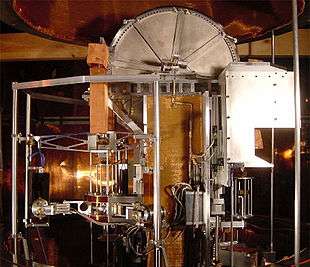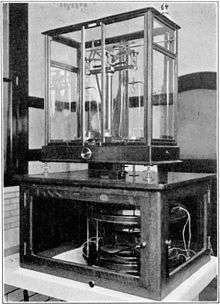Watt balance

A watt balance is an experimental electromechanical weight measuring instrument that measures the weight of a test object very precisely by the strength of an electric current and a voltage. It is being developed as a metrological instrument that may one day provide a definition of the kilogram unit of mass based on electronic units,[1] a so-called "electronic" or "electrical" kilogram. The name watt balance comes from the fact that the weight of the test mass is proportional to the product of the current and the voltage, which is measured in units of watts.
Design

The watt balance is a more accurate version of the Ampere balance, an early current measuring instrument in which the force between two current-carrying coils of wire is measured and then used to calculate the magnitude of the current. In this new application, the balance will be used in the opposite sense; the current in the coils necessary to support the weight of a standard kilogram mass will be measured, "weighing" the kilogram. The weight of the kilogram is then used to compute the mass of the kilogram by accurately determining the local gravitational acceleration. This will define the mass of a kilogram in terms of a current and a voltage, as described below. Since current and voltage units are defined in terms of fundamental physical constants such as the speed of light and Planck's constant, this will provide an alternative definition of the kilogram in terms of these absolute constants. This may be a better definition than the current one, which defines the kilogram as the mass of a physical artifact, the international prototype kilogram, which is vulnerable to deterioration or damage.
Origin
The principle that is used in the watt balance was proposed by B. P. Kibble of the UK National Physical Laboratory (NPL) in 1975 for measurement of the gyromagnetic ratio.[2] The main weakness of the ampere balance method is that the result depends on the accuracy with which the dimensions of the coils are measured. The watt balance method has an extra calibration step in which the effect of the geometry of the coils is eliminated, removing the main source of uncertainty. This extra step involves moving the force coil through a known magnetic flux at a known speed. This step was done in 1990.[3]
The watt balance originating from the National Physical Laboratory was transferred to the National Research Council of Canada (NRC) in 2009, where scientists from the two labs continued to refine the instrument.[4] In 2014, NRC researchers published the most accurate measurement of the Planck constant to date, with a relative uncertainty of 1.8×10−8.[5] Other watt balance experiments are being undertaken in the US National Institute of Standards and Technology (NIST), the Swiss Federal Office of Metrology (METAS) in Berne, the International Bureau of Weights and Measures (BIPM) near Paris and Laboratoire national de métrologie et d’essais (LNE) in Trappes, France.[6]
Principle
A conducting wire of length L that carries an electric current I perpendicular to a magnetic field of strength B will experience a Laplace force equal to BLI. In the watt balance, the current is varied so that this force exactly counteracts the weight w of a standard mass m. This is also the principle behind the ampere balance. w is given by the mass m multiplied by the local gravitational acceleration g. Thus
Kibble's watt balance avoids the problems of measuring B and L with a second calibration step. The same wire (in practice, a coil of wire) is moved through the same magnetic field at a known speed v. By Faraday's law of induction, a Voltage V is generated across the ends of the wire, which equals BLv. Thus
The unknown product BL can be eliminated from the equations to give
With V, I, g, and v accurately measured, this gives an accurate value for m. Both sides of the equation have the dimensions of power, measured in watts in the International System of Units; hence the name "watt balance".
Measurements
Accurate measurements of electric current and voltage are made in conventional electrical units (rather than SI units), which are based on fixed "conventional values" of the Josephson constant and the von Klitzing constant, and respectively. The current watt balance experiments are equivalent to measuring the value of the conventional watt in SI units. From the definition of the conventional watt, this is equivalent to measuring the value of the product KJ2RK in SI units instead of its fixed value in conventional electrical units:
The importance of such measurements is that they are also a direct measurement of the Planck constant h:
The principle of the "electronic kilogram" would be to define the value of the Planck constant in the same way that the meter is defined by the speed of light. In this case, the electric current and the voltage would be measured in SI units, and the watt balance would become an instrument to measure mass:
Any laboratory that had invested the (very considerable) time and money in a working watt balance would be able to measure masses to the same accuracy as they currently measure the Planck constant.
In addition to measuring VI, the laboratory must also measure v and g using experimental methods that do not depend on the definition of mass. The overall precision of m depends on the precisions of the measurements of V, I, v and g. Since there are already methods of measuring v and g to very high precision, the uncertainty of the mass measurement is dominated by the measurement of VI, which is the value measured by the watt balance.
Popular culture
One has even been built from LEGO.[7]
References
- ↑ Palmer, Jason (2011-01-26). "BBC News - Curbing the kilogram's weight-loss programme". Bbc.co.uk. Retrieved 2011-02-16.
- ↑ Kibble, B. P. (1975), Sanders, J. H.; Wapstra, A. H., eds., "A Measurement of the Gyromagnetic Ratio of the Proton by the Strong Field Method", Atomic Masses and Fundamental Constants 5, New York: Plenum, pp. 545–51
- ↑ http://iopscience.iop.org/article/10.1088/0026-1394/27/4/002/meta - A Realization of the SI Watt by the NPL Moving-coil Balance
- ↑ UK National Physical Laboratory: The Watt Balance
- ↑ Sanchez, C A; Wood, B M; Green, R G; Liard, J O; Inglis, D (31 March 2014). "A determination of Planck's constant using the NRC watt balance" (PDF). Metrologia. 51 (2).
- ↑ Mohr, Peter J.; Taylor, Barry N.; Newell, David B. (2008). "CODATA Recommended Values of the Fundamental Physical Constants: 2006". Reviews of Modern Physics. 80 (2): 633–730. arXiv:0801.0028
 . Bibcode:2008RvMP...80..633M. doi:10.1103/RevModPhys.80.633.
. Bibcode:2008RvMP...80..633M. doi:10.1103/RevModPhys.80.633. - ↑ L.S. Chao; S. Schlamminger; D.B. Newell; J.R. Pratt; G. Sineriz; F. Seifert; A. Cao; D. Haddad; X. Zhang (2014-12-04). "A LEGO Watt Balance: An apparatus to demonstrate the definition of mass based on the new SI". arXiv:1412.1699
 .
.
External links
- Steiner, Richard L.; Williams, Edwin R.; Newell, David B.; Liu, Ruimin (October 2005), "Towards an electronic kilogram: an improved measurement of the Planck constant and electron mass." (PDF), Metrologia, 42 (5): 431–441, Bibcode:2005Metro..42..431S, doi:10.1088/0026-1394/42/5/014, retrieved 2009-11-17
- Joshua P. Schwarz, Ruimin Liu, David B. Newell, Richard L. Steiner, Edwin R. Williams, Douglas Smith "Hysteresis and Related Error Mechanisms in the NIST Watt Balance Experiment" (August 2001)
- Bureau International des Poids et Mesures
- Swiss Federal Office of Metrology